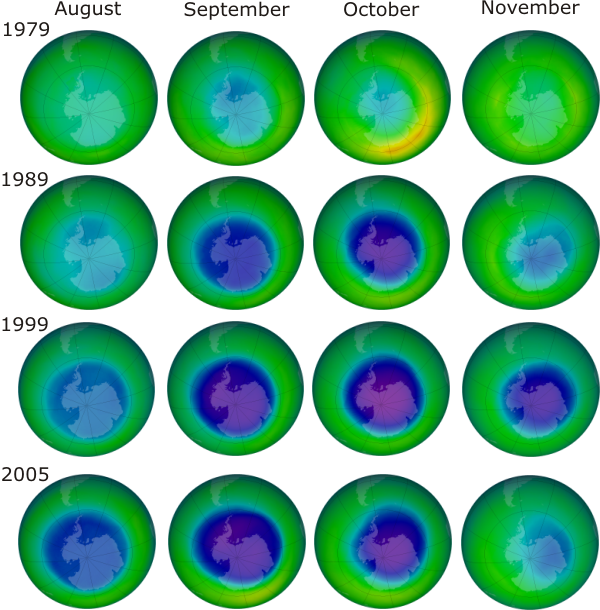I'm somewhat late commenting on the story that the Antarctic ozone hole appears to have stopped growing, but I put together this figure last week by pulling images off the NASA Ozone Hole Watch website (click here for the latest image from this year), and it seems a shame to waste it. It depicts how the springtime concentration of ozone over the south pole has varied since 1979. Blue and purple indicate low ozone concentrations, green and yellow high concentrations. 
This figure provides a qualitative impression - that the area of ozone depletion in the 2005 season was not enormously bigger or deeper than in 1999, and in fact appeared to recover a little earlier. This impression is confirmed by the more rigorous (but less pretty) figure below, which shows the annual variation in the size of the ozone hole since 1979 - click on it for the original (and clearer) version at this NASA site, where you can also see how the severity of ozone depletion has varied. 
So it seems that in fact things have been stabilising for a while now - the sudden media interest can be traced to a NOAA press release to mark the 20 year anniversary of the study that confirmed that chlorine, released when CFCs are broken down by ultraviolet radiation, was the cause of ozone depletion above Antarctica. This work combined with a rare outbreak of non-partisan international cooperation to produce the Montreal Protocol. Even more remarkably, the agreement was actually pretty effective at curtailing the production of CFCs and other ozone-damaging chemicals: 
(source)
However, the important thing to notice is that the thinning of the ozone layer above Antartica continued throughout the 1990s; although we cut the production of ozone-destroying chemicals, the molecules of those we have already released are persistant beasties, surviving in the atmosphere for anything up to 100 years. Indeed, as the graph here shows, the atmospheric concentration of flourocarbons has merely stablised in the last decade. Until it begins to fall, springtime ozone depletion above the Antarctic will continue (the latest research estimates full recovery in about 2065). The fact that our atmosphere is still suffering the consequences of CFC emitted two decades ago is a warning about the consequences of the other changes we have wrought on atmospheric chemisty. Even if we can agree to seriously cut the emission of greenhouse gases in the next decade or two, the full effect of what we've already emitted, and are currently emitting, will not play out for a long time afterwards (especially since climate change affects the ocean, which responds over timescales of centuries, not decades). More people need to realise that emissions cuts will not put the brakes on climate change; it is more akin to taking your foot off the accelerator.
01 September, 2006
The long road to ozone hole recovery
Posted by
Chris R
at
2:50 pm
![]()
Labels: climatology, environment
Subscribe to:
Post Comments (Atom)




1 comment:
The cool thing about the ozone hole and global warming is their interaction with each other.
For example, ozone is a greenhouse gas, so the current hole exerts a cooling effect equal to the CO2 and methand based warming.
On the other hand, the reactions that allow clorine ions to photochemically break down ozone work best at very low temperature, so you would expect them to work less efficiently in a warmer world.
Unless, of course, the ozone is in the part of the stratosphere expected to cool as the troposphere warms... Can you tell my atmospheric chemistry is rusty?
Post a Comment